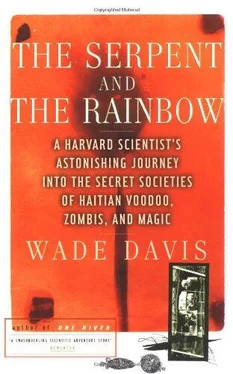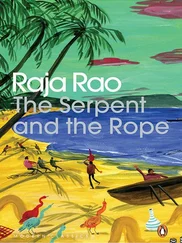Wade Davis - The Serpent and the Rainbow
Здесь есть возможность читать онлайн «Wade Davis - The Serpent and the Rainbow» весь текст электронной книги совершенно бесплатно (целиком полную версию без сокращений). В некоторых случаях можно слушать аудио, скачать через торрент в формате fb2 и присутствует краткое содержание. Год выпуска: 1985, Издательство: Simon & Schuster, Жанр: Старинная литература, на английском языке. Описание произведения, (предисловие) а так же отзывы посетителей доступны на портале библиотеки ЛибКат.
- Название:The Serpent and the Rainbow
- Автор:
- Издательство:Simon & Schuster
- Жанр:
- Год:1985
- ISBN:нет данных
- Рейтинг книги:5 / 5. Голосов: 1
-
Избранное:Добавить в избранное
- Отзывы:
-
Ваша оценка:
- 100
- 1
- 2
- 3
- 4
- 5
The Serpent and the Rainbow: краткое содержание, описание и аннотация
Предлагаем к чтению аннотацию, описание, краткое содержание или предисловие (зависит от того, что написал сам автор книги «The Serpent and the Rainbow»). Если вы не нашли необходимую информацию о книге — напишите в комментариях, мы постараемся отыскать её.
The Serpent and the Rainbow — читать онлайн бесплатно полную книгу (весь текст) целиком
Ниже представлен текст книги, разбитый по страницам. Система сохранения места последней прочитанной страницы, позволяет с удобством читать онлайн бесплатно книгу «The Serpent and the Rainbow», без необходимости каждый раз заново искать на чём Вы остановились. Поставьте закладку, и сможете в любой момент перейти на страницу, на которой закончили чтение.
Интервал:
Закладка:
The Efik were no more cooperative with the Europeans. They demanded lines of credit and were regularly entrusted with trade items—salt, cotton cloth, iron, brass, and copper valued in the thousands of pounds sterling. In addition to exchanging goods for slaves, the Europeans had to pay a duty for the privilege of trading with the Efik chiefs. Though some of the slave ships anchored off the coast for up to a year, no European was ever permitted to touch the shore; they could only wait, sometimes for months, to pick up their cargo.
Apparently each major Efik settlement was ruled outwardly by an obong , or chief, who enforced laws, mediated in disputes, and led the armed forces in times of war. Besides this secular authority, however, there was a second and perhaps more powerful social and political force, a secret society called the Egbo , or leopard society. The Egbo was a male hierarchical association consisting of several ranks, each of which had a distinctive costume. Although the Egbo and the secular authority were institutionally separate, in practice powerful individuals of the tribe sat in council for both groups. Fear of the clandestine and mysterious Egbo was often exploited by members of the secret society themselves, and the obong invariably ranked high in the society.
Under a secret council of community elders that constituted the supreme judicial authority, the leopard society promulgated and enforced laws, judged important cases, recovered debts, and protected the property of its members. It enforced its laws with a broad range of sanctions. It could impose fines, prevent an individual from trading, impound property, and arrest, detain, or incarcerate offenders. Serious cases resulted in execution, by either decapitation or fatal mutilation—the victim was tied to a tree with his lower jaw sliced off.
The tribunal of the secret society determined guilt or innocence by a judgment of a most singular form. The accused was made to drink a toxic potion made from eight seeds of the Calabar bean, ground and mixed in water. In such a dose, physostigmine acts as a powerful sedative of the spinal cord, and causes progressively ascending paralysis from the feet to the waist, and eventual collapse of all muscular control, leading to death by asphyxiation. The defendant, after swallowing the poison, was ordered to stand still before a judicial gathering until the effects of the poison became noticeable. Then he was ordered to walk toward a line drawn on the ground ten feet away. If the accused was lucky enough to vomit and regurgitate the poison, he was judged innocent and allowed to depart unharmed. If he did not vomit, yet managed to reach the line, he was also deemed innocent, and quickly given a concoction of excrement mixed with water which had been used to wash the external genitalia of a female.
Most often, however, given the toxicity of the Calabar bean, the accused died a ghastly death. The body was racked with terrible convulsions, mucus flowed from the nose, the mouth shook horribly. If a person died from the ordeal, the executioner gouged out his eyes and cast the naked body into the forest.
At any one time during the later years of the slave trade, the Efik lands were crowded with newly acquired slaves, most of them thoroughly demoralized. To keep order and discipline, the Efik depended on the agents and executioners of the Egbo. During the weeks and sometimes months that the slaves were held awaiting shipment to the Americas, they must have heard of the gruesome ordeal of the Calabar bean, and many may have undergone the judgment themselves.
Here was an exciting possibility. Datura was a violently psychoactive plant well known and widely used in Africa as a stuporific poison by at least some of the peoples that had been exported to Haiti. The Calabar bean, which yields the recognized medical antidote for datura poisoning, came from the same region, and knowledge of its toxicity would almost certainly have passed across the Atlantic. African species of datura were apparently common throughout contemporary Haiti. The Calabar bean, though unreported from Haiti, has a hard outer seed coat and could have easily survived the transoceanic passage, and like datura it could have been later sown deliberately or accidentally, in the fertile soils of Saint Domingue.
Thus after a day in the library I had something concrete, a hypothesis that, however tenuous, at least fitted the sparse facts of the case. Knowledge of the pharmacological properties of these two toxic African plants presumably traveled across the Atlantic with the slaves to Saint Domingue. Then, adapted to fit new needs, or perhaps conserved as adjuncts to ancient magical practices, they provided the material basis upon which the contemporary belief in zombis was founded. My Calabar hypothesis was only conjecture, but at least it was a beginning, a skeletal framework on which other ideas and new information could be draped, until a solution to this extraordinary mystery took form.
The hypothesis was simple and elegant but, as it would turn out, quite wrong. Yet in pursuing it I had unwittingly uncovered a sociological connection that would eventually prove a key to the entire zombi phenomenon—the secret societies of the Efik.
4
White Darkness and the Living Dead
I TRAVELED to Haiti in April 1982, armed only with my tentative hypothesis, Kline’s introduction to Lamarque Douyon, the Port-au-Prince psychiatrist who had in his clinic Clairvius Narcisse, and two names I received from the BBC in London: Max Beauvoir, described as a sophisticated member of the Haitian intellectual elite and a noted authority on the vodoun religion; and Marcel Pierre, the vodoun priest, or houngan , from whom the BBC had obtained their sample of the reputed poison, a man one of their correspondents had labeled the “incarnation of evil.”
As my plane approached Haiti, it was not hard to understand why Columbus had responded as he had when asked by Isabella to describe the island of Hispaniola. He had taken the nearest piece of paper, crumpled it in his hand, and thrown it on the table. “That,” he had said, “is Hispaniola.”
Columbus had come to Haiti by way of the island of San Salvador, his first landfall in the Americas, where the natives had told enticing tales of a mountainous island where the rivers ran yellow with soft stones. The admiral found his gold, but more excitedly he discovered a tropical paradise. In rapture he wrote back to his queen that nowhere under the sun were there lands of such fertility, so void of pestilence, where the rivers were countless and the trees reached into the heavens. The native Arawaks he praised as generous and good, and he beseeched her to take them under her protection. This she did. The Spaniards introduced all the elements of sixteenth-century civilization, and as a result within fifteen years the native population was reduced from approximately half a million to sixty thousand. European rapacity carved away the forest as well, and with the disappearance of the rich stands of lignum vitae and mahogany, rosewood, and pine, the delicate tropical soils turned to dust and blackened the rivers. Now, looking out of the plane at the barren slopes and the dry, desolate landscape, I saw the European arrival on that island four hundred years before like the coming of a plague of locusts.
The capital city of Port-au-Prince lies prostrate across a low, hot tropical plain at the head of a bay flanked on both sides by soaring mountains. Behind these mountains rise others, creating an illusion of space that absorbs Haiti’s multitudes and softens the country’s harshest statistic: a land mass of only ten thousand square miles inhabited by six million people. Port-au-Prince is a sprawling muddle of a city, on first encounter a carnival of civic chaos. A waterfront shantytown damp with laundry. Half-finished, leprous public monuments. Streets lined with flamboyant and the stench of fish and sweat, excrement and ash. Dazzling government buildings and a presidential palace so white that it doesn’t seem real. There are the cries and moans of the marketplace, the din of untuned engines, the reek of diesel fumes. It presents all the squalor and grace of any Third World capital, yet as I drove into the city for the first time, I noticed something else. The people on the street didn’t walk; they flowed, exuding pride. Physically they were beautiful. They seemed gay, careless, jaunty. Washed clean by the afternoon rain, the whole city had a rakish charm. And it wasn’t just how things appeared, it was something in the air, something electric—a raw elemental energy I had never felt elsewhere in the Americas. Yet while I sensed this feeling immediately, and remained aware of it constantly during all the months I was to spend in the country, I would not understand it for some time. That first day coming in from the airport, however, I did receive a clue—a sight I would see many times again in Haiti. There in the late afternoon sun was a single individual, quite sane and very happy, standing alone, dancing with his own shadow.
Читать дальшеИнтервал:
Закладка:
Похожие книги на «The Serpent and the Rainbow»
Представляем Вашему вниманию похожие книги на «The Serpent and the Rainbow» списком для выбора. Мы отобрали схожую по названию и смыслу литературу в надежде предоставить читателям больше вариантов отыскать новые, интересные, ещё непрочитанные произведения.
Обсуждение, отзывы о книге «The Serpent and the Rainbow» и просто собственные мнения читателей. Оставьте ваши комментарии, напишите, что Вы думаете о произведении, его смысле или главных героях. Укажите что конкретно понравилось, а что нет, и почему Вы так считаете.












